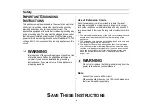
17
Cooking Instructions
Guide for Cooking Eggs in Your Microwave
•
Never cook eggs in the shell, and never warm hard-cooked eggs in the
shell; they can explode.
•
Always pierce whole eggs to keep them from bursting.
•
Cook eggs just until set; they become tough if overcooked.
Guide for Cooking Vegetables in Your Microwave
•
Vegetables should be washed just before cooking. Often, no extra water
is needed. If dense vegetables such as potatoes, carrots and green
beans are being cooked, add about ¼ cup water.
•
Small vegetables (sliced carrots, peas, lima beans, etc.) will cook faster
than larger ones.
•
Whole vegetables, such as potatoes, acorn squash or corn on the cob,
should be arranged in a circle on the turntable before cooking. They will
cook more evenly if turned over after half the cooking time.
•
Always place vegetables like asparagus and broccoli with the stem ends
pointing towards the edge of the dish and the tips toward the center.
•
When cooking cut vegetables, always cover the dish with a lid or vented
microwavable plastic wrap.
•
Whole, unpeeled vegetables such as potatoes, squash, eggplant, etc.,
should have their skin pricked in several spots before cooking to prevent
them from bursting.
•
For more even cooking, stir or rearrange whole vegetables halfway
through the cooking time.
•
Generally, the denser the food, the longer the standing time. (Standing
time refers to the time necessary for dense, large foods and vegetables
to finish cooking after they come out of the oven.) A baked potato can
stand on the counter for five minutes before cooking is completed, while
a dish of peas can be served immediately.
Auto Defrosting Guide
•
Follow the instructions below when defrosting different types of food.
Notes
Check foods when the oven signals. After the final stage, small sections may
still be icy; let them stand to continue thawing. Do not defrost until all ice
crystals have thawed. Shielding roasts and steaks with small pieces of foil
prevents the edges from cooking before the center of the food has defrosted.
Use narrow, flat, smooth strips of aluminum foil to cover the edges and thin-
ner sections of the food.
Food
Standard
Amount
Procedure
Roast
Beef, Pork
2.5-6.0 lbs.
Start with the food placed fat side down. After
each stage, turn the food over and shield any
warm portions with narrow strips of aluminum
foil.
Steaks,
Chops,
Fish
0.5-3.0 lbs.
After each stage, rearrange the food. If there
are any warm or thawed portions of food,
shield them with narrow flat pieces of
aluminum foil. Remove any pieces of food that
are nearly defrosted. Let stand, covered, for 5-
10 minutes.
Ground
Meat
0.5-3.0 lbs.
After each stage, remove any pieces of food
that are nearly defrosted. Let stand, covered
with foil, for 5–10 minutes.
Whole
Chicken
2.5-6.0 lbs.
Remove giblets before freezing poultry. Start
defrosting with the breast side down. After the
first stage, turn the chicken over and shield
any warm portions with narrow strips of
aluminum foil. After the second stage, again
shield any warm portions with narrow strips of
aluminum foil. Let stand, covered, for 30–60
minutes in the refrigerator.
Chicken
Pieces
0.5-3.0 lbs.
After each stage, rearrange or remove any
pieces of food that are nearly defrosted. Let
stand for 10-20 minutes.








































